The use of nuclear materials in Canada is tightly regulated by the Canadian Nuclear Safety Commission (CNSC), which reports to Parliament through the Minister of Natural Resources. McMaster University holds several licenses from the CNSC that enable nuclear research activities on campus.
Day-to-day operation of McMaster Nuclear Reactor is overseen by the Manager of Reactor Operations, who ensures that all work is carried out in a safe and appropriate manner that is in keeping with the terms of MNR’s operating license. The Manager reports to the Director of Nuclear Facilities, who reports to two independent McMaster-based committees: the Health Physics Advisory Committee (HPAC), which oversees the use of radioactive materials on campus, and the Nuclear Facilities Control Committee (NFCC), the regulatory body responsible for the safe and compliant operation of the nuclear reactor and the other Class II nuclear facilities on the McMaster University campus.
The HPAC reports directly to the President of the University, while the NFCC is accountable to the Vice President, Research and International Affairs at McMaster University. Both committees also report to the federal regulator, the Canadian Nuclear Safety Commission (CNSC).
The reactor is subjected to regular inspections by the CNSC, as well as by the International Atomic Energy Agency, the United Nations organization that oversees the use of nuclear materials for peaceful purposes around the world.
Learn more about the Canadian Nuclear Safety Commission (CNSC).
Expandable List
The Health Physics Department ensures the safety, continuous monitoring and training for all those who deal with radiation in the McMaster community. We work together with the radioactive material handlers and are always willing to discuss the most effective procedure in order to maintain doses well below the regulated maximums. It is our responsibility to monitor every location on campus which uses radioactivity whether it be a hospital, reactor, or lab.
McMaster University has a comprehensive radiation safety program that is implemented and overseen by the Health Physics Department and the university’s Senior Health Physicist. The program covers the extensive nuclear infrastructure on campus, including the nuclear medicine department at the hospital, licensed radioisotope laboratories in nearly a dozen buildings, X-ray sources and instruments, sealed sources of radioactivity, an extensive High Level Laboratory Facility for work with large quantities of radioisotopes, a 3 MV Van De Graaff Accelerator, a 1.25 MV tandem accelerator, two cyclotrons, and, of course, the nuclear reactor. The objectives of the radiation safety program are both to ensure that nuclear scientists and technicians are exposed to a minimum of ionizing radiation, and to protect McMaster students, employees, and residents in the surrounding community from any potentially harmful effects of the nuclear infrastructure on campus. The watchword for the radiation protection program is “ALARA”, meaning that work with nuclear materials is planned and carried out in such a way that exposure to ionizing radiation is kept As Low As Reasonably Achievable.
Radiation Safety & MNR’s Nuclear Energy Workers
Routine tasks at MNR are carried out according to standard procedures that have been approved by the Health Physics Department: any changes to existing procedures must be approved in advance. Radiation exposure to MNR staff is kept to a minimum by careful design of procedures and implementation of good work practices, such as recalling the principles of radiation protection: time, distance, and shielding. The time spent handling nuclear materials is kept to a minimum by the highly trained staff members; the distance between the worker and the nuclear material is maximized using remote handling tools; and radioactive materials are encased in lead or dense plastic containers to provide shielding from radioactive samples by attenuating the radiation they emit. Highly radioactive samples are handled in specially designed facilities such as MNR’s industrial hot cell, which is constructed of thick lead, to prevent radiation exposure to the worker.
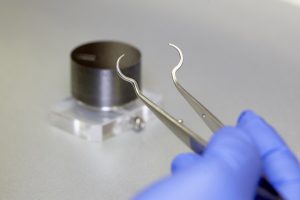


Staff members conducting work with radioactive materials at MNR have Nuclear Energy Worker status, meaning that they have received instruction in the effects of ionizing radiation and both acknowledge and accept the potential hazards of their work. Each staff member who works with nuclear materials within the reactor containment building is issued an Electronic Personal Dosimeter (EPD), a device that provides real-time monitoring of the radiation dose the worker has sustained, and the rate at which dose is being accrued. The device “chirps” when the dose rate is above a prescribed threshold, providing an auditory indication to the wearer to step back and reassess the situation. Radiation doses to personnel are reviewed regularly for trending and analysis purposes and to ensure that they are within both the legal limits set by the CNSC and the far more stringent Administrative Control Levels set by the Health Physics Department.
In addition to personal dosimeters, the reactor containment building is equipped with thirteen area monitors that provide local, real-time measurements of radiation dose rates so that any minor increases in radiation levels can be detected and addressed promptly. There are also two continuous air samplers fitted with filtration assemblies in place to record levels of radioactivity in airborne particulate matter; radioactivity in the air inside the containment building is also examined in order to detect and quantify the gaseous fission product argon-41. Because one of the major commercial activities at MNR is the production of iodine-125, a potentially volatile radioisotope, four additional continuous air monitors equipped with charcoal filters that absorb iodine are in place to collect and quantify this species. The data produced by these monitoring devices are used to ensure that the levels of radioactivity inside the containment building are below both the legal release limits set by the Canadian Nuclear Safety Commission (CNSC) and the Administrative Control Levels set by the Health Physics Department, which are approximately 100 times lower than the levels permitted by the CNSC.
The dedication of MNR personnel to radiation safety was recognized in 2003, when the “MNR I-125 ALARA Team” was named a recipient of the President’s Award for Outstanding Service to McMaster University. The team was composed of members of the Health Physics Department and MNR staff members involved with the production of the medical radioisotope Iodine-125: the team’s objective was to reduce radiation doses to Iodine-125 production technicians to As Low As Reasonably Achievable (ALARA) levels. The team undertook a comprehensive and systematic review of the Iodine-125 production process, and several procedural modifications were implemented in consequence. The ultimate result of this study was a 93% reduction of the radiation doses sustained by the Iodine-125 production staff, which has allowed them to continue producing this cancer-treating radioisotope safely.
McMaster Nuclear Reactor has a strong workplace and radiation safety training program for its staff that includes regular “refresher” sessions. All work with nuclear materials at MNR is carried out by highly qualified personnel who have received extensive training in the safe and correct performance of their job duties. A Reactor Operator, for example, is required to have a minimum of two years experience on the job prior to being eligible to write a certification exam that will allow him/her to be the primary operator of the nuclear reactor. The examination requires the examinee to demonstrate both theoretical and practical knowledge of all facets of reactor operations, and is overseen by the Canadian Nuclear Safety Commission.
Safety is a top priority at MNR: qualified staff members conduct regular checks and preventative maintenance on all equipment and instrumentation associated with the nuclear reactor in order to ensure its continued safe operation. Staff also participate in training exercises such as the fire response scenario of 2010 that was coordinated by the Health Physics Department and Reactor Operations, in conjunction with McMaster University Security Services and Hamilton Emergency Services. With CNSC observers on hand to judge the appropriateness of the response, a firefighter with Hamilton Emergency Services placed a device in the depths of the reactor containment building that would trigger the fire alarm. As the alarm sounded, reactor staff promptly evacuated the building and emergency personnel (firefighters and Health Physics staff) took over the scene. This exercise was documented in a series of photographs taken by the Science Media Lab, some of which are shown below.
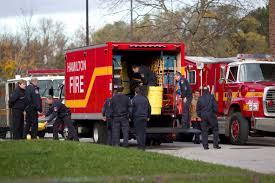
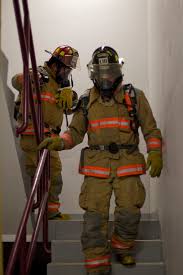
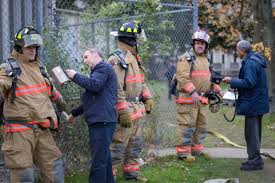
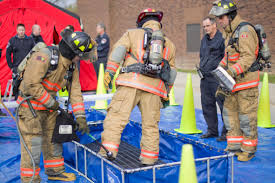
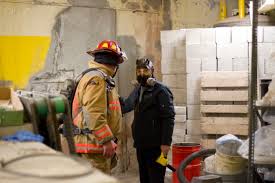
All photos courtesy of the Science Media Lab.
McMaster University’s Nuclear facilities are operated in a manner that is consistent with public safety and within the terms of the facility licenses granted by the Canadian Nuclear Safety Commission and internal operating limits and conditions.
To achieve the objective of safe operation within a good safety culture, MNR applies the following safe practices to all areas:
- Changes require independent review and approval before implementation
- All work to be performed in compliance with the Work Control Program
- Any member of the work team shall refuse any order which contravenes approved procedures
- Good work management practices shall be implemented in all areas
- Good work control practices shall be implemented in all areas
McMaster University’s Nuclear Facilities shall be operated in a manner that is consistent with public safety and within the terms of the facility licences granted by the Canadian Nuclear Safety Commission (CNSC). The Nuclear Facilities Control Committee (NFCC) shall determine if this objective is being achieved through review and audit of facility operations.
